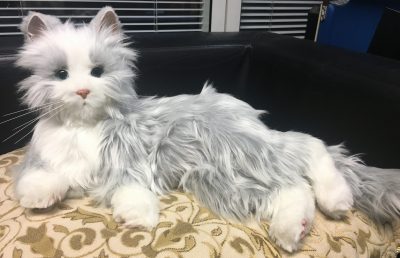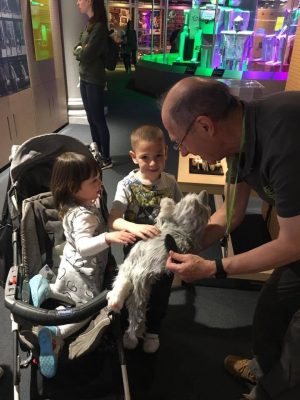The British Museum might have had real cats but our Science Museum robot cat has become a firm favourite. Volunteer Coordinator Caroline Chestnutt tells us more.

At first glimpse it might look like we have a real life cat in our Robots exhibition; however on closer inspection you’ll realise that this is in fact, a robot.
If you’ve already visited our ‘Robots’ exhibition you may have been lucky enough to meet our wonderful Robots Engagement Volunteers supporting pop-up object handling. Undoubtedly the most popular objects with the public are the Hasbro Joy for All Companion Pets.

It might seem a little odd that within an exhibition focusing on humanoid robots that we have a pair of robotic animals, however there is method in the madness. A team of ten volunteers researched the exhibition themes and carefully chose a group of objects for handling inside ‘Robots’. One of the themes explored in Imagine, the final section of the exhibition, is robots that care for us.
The idea of a robot caring for us isn’t something that appeals to everyone, but how about an animal that provides comfort and reassurance? The basic principals of Animal Assisted Therapy are that spending time with an animal can improve your social and emotional wellbeing. This therapeutic technique has been around for a long time and scientific research has shown how it can improve the lives of dementia and Alzheimer sufferers.
Spending time with a live animal isn’t always possible, however, which is why the PARO therapeutic robot was born, or should I say created, by AIST a Japanese automation company. PARO has been modelled as a white baby harp seal and has sensors to react like a real animal. This friendly robot has been used in medical centres throughout Japan and Europe to provide a catalyst for interaction between patients and caregivers.
The basic principles of the Companion pets are similar, to provide comfort and companionship to older people in care homes, however I’m inclined to agree with the box –they’re suitable from 5 to 105!
You can see the companion pets along with over 100 other Robots in the ‘Robots’ exhibition until 3 September.
We are currently recruiting for new Robots Engagement Volunteers to join our team. If you’d like to apply for this role, search our current vacancies or email volunteer@sciencemuseum.ac.uk for more information, applications close 23rd April.